|
Title: | BR Rolling Stock Fleet Survey |
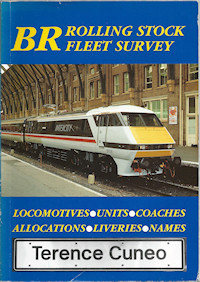
|
| Author: | Roger Wood |
| Publisher: | Andred Publishing, Sheering |
| Format: | Book |
| Subject: | Rolling Stock |
| Category: | Numbers - Current |
| Spec: | A5, 104 pages, card covers, 3 colour photos (covers only), 24 B&W photos, ISBN: 0-9516014-0-7 |
| Publication date: | 1990 |
| Summary: | This book seems to have been aimed at filling the gap left in the ABC market by Ian Allan's withdrawal. Although a quality production, it does not appear to have been repeated. |
| Review: | Despite its name and size (a slim A5 volume), this is in fact a fairly ordinary ABC-type book, and not a bad one at that. Sub-titled the Summer 1990 edition, and correct to May 1990, this book was compiled by Roger Wood. The introduction states that the book omits some technical information (such as EMU set formations) that had not changed since the Ian Allan books that were published in 1989. Perhaps its appearance was a result of Ian Allan not doing their classic Combined Volume in 1990 (or any year since). Roger Wood had done the last Ian Allan book, and he was also responsible for the news and stock change in that publisher's Motive Power Monthly magazine. These sometimes appeared under the pseudonym Andred, and the book reviewed here was actually published by Andred Publishing, while the typesetting (which is very neat) was by Coorlea Graphics, who later published several books about coach and unit histories by Ashley Butlin. Ian Allan's decision to stop producing ABCs was no doubt due to the popularity of the relatively new competition from Platform 5. This may also explain why this potential successor appears to have been a one-off.
The book itself is pretty good, with all the information that an average enthusiast or spotter would need. Besides the sections shown in the page samples below, there were also lists of liveries, depots, pool codes (those for locos also listing the numbers), names, departmental units and HST formations. Yet there was still room for a good selection of photos that were all well reproduced. |
| Reviewed: | 07/03/2023 by Thomas Young (Comments made by others can appear in the notes section towards the bottom of this page) |
| Sample pages: | (Click on any image to view full-sized in a new window)

The image at the bottom of the cover is a photo of a loco nameplate, but at least one book seller's website lists this title as being written by Terence Cuneo!
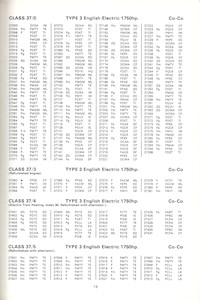
The bulk of the content is a normal ABC-type listing, with numbers, liveries (blank means standard blue or blue/grey) allocations and sector codes.
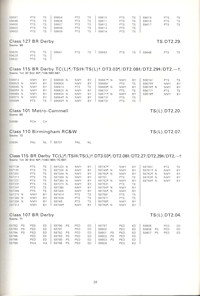
First-generation DMUs are listed by individual car numbers. Note that TOPS diagram variations are included (by symbols).
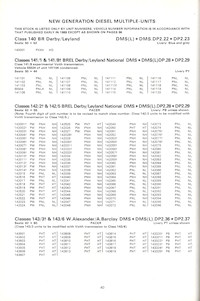
Second-generation DMUs are shown by set numbers only, and the intro refers readers to the 1989 combined volume. However, the TOPS diagrams for the individual cars are provided. At the time of publication, a mass-renumbering of railbuses was proposed.
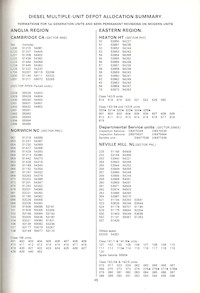
An allocation summary for DMUs showed set formations (and set numbers where appropriate) for 1st-gen units, but just set numbers for 2nd-gen ones.
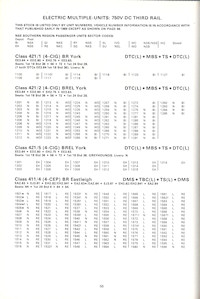
EMU stock was treated the same way as 2nd-gen DMUs, with set numbers only, though again the individual diagram numbers were shown. Liveries were shown in the headings in cases where an entire batch had the same colours.
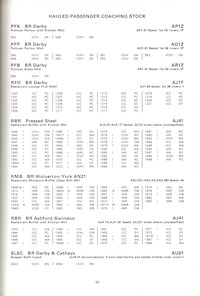
Coaching stock was well covered, with liveries, allocations and pools, plus TOPS codes and diagrams.
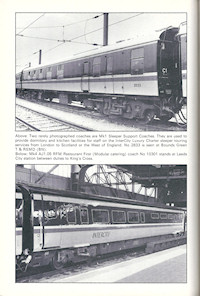
The inside photos are well printed and cover various subjects, though not surprisingly biased towards locos.
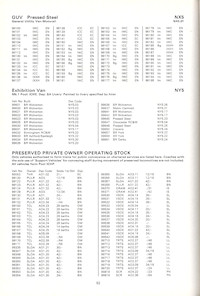
Even private-owner coaching stock was included, with individual diagram numbers (they are referred to here as design codes but I believe that the 5-character codes were normally called diagrams).
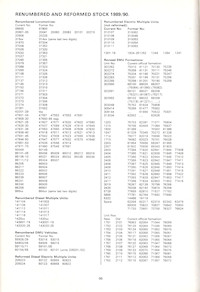
Three pages towards the back of the book detail changes between early 1989 and May 1990, including details not shown elsewhere in the book (such as renumberings and formations).
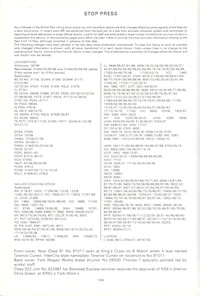
A feature carried over from the Ian Allan ABCs was the inclusion of a page of late news at the back. I know that some people did not like this, as it meant they had to decide whether to manually update the main pages. Production was not as quick back then, so I suppose this was needed, though I don't think Platform 5 ever did it. |
| Notes: |
No notes have been left yet. ?There may be some notes posted but which have not yet been approved.
|
| Edits: | This item has not been edited.
|

 Register
Register